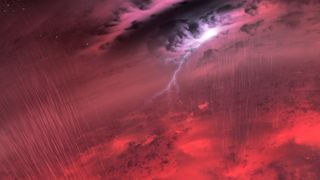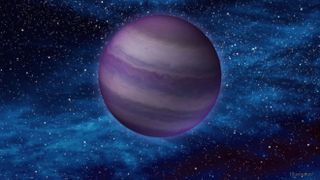On bizarre brown dwarf worlds, astronomers spot hot, sandy clouds
Beyond Earth, clouds go wild.

NASA's Spitzer Space Telescope spotted a sandstorm special.
Sandy or (silicate-rich) clouds were confirmed in bizarre, gassy objects known as brown dwarfs, which are between the size of a planet and a star. Since these oddball objects have no solid surface, how the sand grains got so high in their planets' atmospheres was a mystery to scientists, despite suspicions of observed silicates for at least the past decade.
New modeling based on archival data from the retired Spitzer Space Telescope mission, however, suggests that conditions required for high-altitude sandy clouds can arise in a certain temperature and chemistry range. The implications will be useful for scientists trying to make sense of the range of exoplanet atmospheres present in our universe, officials at NASA's Jet Propulsion Laboratory (JPL) in California noted in a statement on July 7.
Related: These 10 super extreme exoplanets are out of this world
Spitzer, which JPL managed, collected data suggesting the presence of silicate clouds in a few brown dwarfs during the first six years of its mission, between 2003 and 2009, while its infrared vision benefited cryogenically cooled instruments. Ultra-cool conditions are required to seek out infrared light in many wavelengths, so Spitzer's prime mission concluded in 2009 after the telescope ran out of the liquid helium coolant necessary for two of its three instruments. The observatory shut down permanently in 2020.
(Happily, NASA's newly launched James Webb Space Telescope in deep space is also an infrared observer and will be able to pick up the research, scientists said.)

Scientists deemed Spitzer's initial data collection "too weak to stand on its own," requiring further observations. In the current work, researchers collected 100 marginal detections of silicates in Spitzer's archives and grouped them by brown dwarf temperature.
Get the Space.com Newsletter
Breaking space news, the latest updates on rocket launches, skywatching events and more!
The suspected silica clouds, though hard to see or confirm, were right in the temperature range where silica can condense in an atmosphere: between about 1,900 degrees Fahrenheit (about 1,000 degrees Celsius) and 3,100 F (1,700 C).

Silica condensation is a matter of chemistry. Rock can vaporize, cool and condense into clouds just like water, although at higher temperatures. Silicate clouds should therefore only be visible on hotter worlds, including brown dwarfs and some high-temperature planets outside the solar system.
The new data gives further strength to the old Spitzer work, lead author Genaro Suárez, a postdoctoral researcher at Western University, said in the JPL statement. "We were very surprised at how strong the conclusion was once we had the right data to analyze," Suárez said.
Silicate clouds might even be present far down in Jupiter's atmosphere, due to higher temperatures (themselves due to greater atmospheric pressure) in that zone relative to the regions closer to the cloud tops. There, however, silicate clouds cannot rise high up within easy view because of the lower planetary temperature; the silicates solidify in these conditions and remain at lower altitudes.
A peer-reviewed study based on the research was published in May in the Monthly Notices of the Royal Astronomical Society.
Follow Elizabeth Howell on Twitter @howellspace. Follow us on Twitter @Spacedotcom and on Facebook.
Join our Space Forums to keep talking space on the latest missions, night sky and more! And if you have a news tip, correction or comment, let us know at: community@space.com.

Elizabeth Howell (she/her), Ph.D., is a staff writer in the spaceflight channel since 2022 covering diversity, education and gaming as well. She was contributing writer for Space.com for 10 years before joining full-time. Elizabeth's reporting includes multiple exclusives with the White House and Office of the Vice-President of the United States, an exclusive conversation with aspiring space tourist (and NSYNC bassist) Lance Bass, speaking several times with the International Space Station, witnessing five human spaceflight launches on two continents, flying parabolic, working inside a spacesuit, and participating in a simulated Mars mission. Her latest book, "Why Am I Taller?", is co-written with astronaut Dave Williams. Elizabeth holds a Ph.D. and M.Sc. in Space Studies from the University of North Dakota, a Bachelor of Journalism from Canada's Carleton University and a Bachelor of History from Canada's Athabasca University. Elizabeth is also a post-secondary instructor in communications and science at several institutions since 2015; her experience includes developing and teaching an astronomy course at Canada's Algonquin College (with Indigenous content as well) to more than 1,000 students since 2020. Elizabeth first got interested in space after watching the movie Apollo 13 in 1996, and still wants to be an astronaut someday. Mastodon: https://qoto.org/@howellspace
